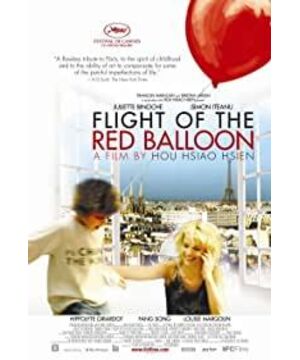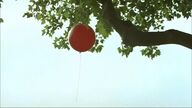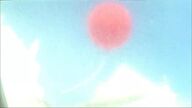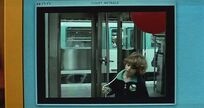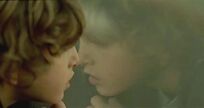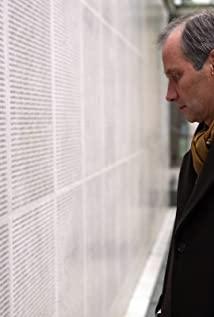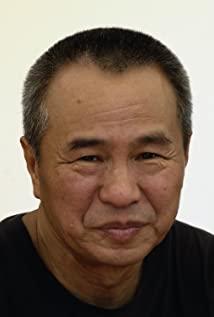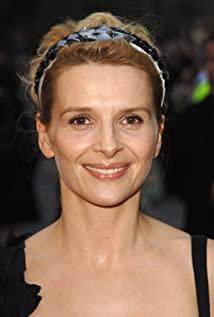She mentioned that Hou's "Flowers on the Sea" was filmed, and some foreign reporters said that there seemed to be no action in the film, and all they saw was what happened before the characters narrated, or what will happen afterward. Hou said this was exactly the effect he was after. In the stage of script conception and creation, he asked to trace the past and present life of a character to make them plump and vivid, and then in the film, he was not interested in what happened to these people, but focused on his current state of existence. When watching a movie, what the audience sees is just plain life, maybe nothing happened, but it can also give birth to a heart of understanding about a character's life.
This explanation also applies to this "Red Balloon Journey": the film tells the story of a Chinese female student studying film who came to a French family to work part-time to take care of a little boy. The child's mother is a professional puppet show voice actor, taking care of the child alone , rushing around all day for life and work. In addition to the whole picture of Paris and a glimpse of the streets, the whole movie almost unfolds in a small apartment living room. The house is cramped because it is cluttered with all kinds of things. Usually, when there are people at home, there are almost constant neighbors to disturb: borrow the kitchen to cook, children go downstairs to learn to play the piano... and a female student , I feel that people have to give way when walking between people. The hostess often doesn't even bother to close the door at all. Such old-fashioned houses are very typical in Paris. The whole film does not have a specific event that promotes the development of the plot. The audience keeps watching the family's life go by day by day, over and over again, it seems that there is no change, it is very "life flow". We get the occasional call from mom about her entanglements with her child's father and the circumstances of her life on and off. And all this, she can't say it to the child, nor to the unfamiliar Chinese girl.
Juliette Binoche - French review article says this is the best role the French actress has ever played. In the past, she was always asked to play some calm intellectual women, but she did not give full play to her comedy cells. Juliet Binoche plays a single mother raising her son alone, earning money to support her family, and can't delay her work and life. In the impression, she was hurrying around with her unkempt blonde hair on, and she didn't see her face clearly at all. With the slow development of the waiting-style plot, people watched her and her son's day-to-day life and gradually entered the heart of this seemingly messy woman.
Song Fang - Chinese girl studying in France. I suspect this is who she really is: studying filmmaking in Paris and doing odd jobs. The performance is very real, including French with a Chinese accent, and the feeling of interacting with French people as a Chinese girl. Reminds me of myself years ago. Dad Man said that the film was too real, made Parisian life too realistic, and might not be of interest to the average French audience (he likes high-tech sci-fi or fairy tales like The Matrix or The Lord of the Rings) "The Promise" is also his favorite "non-realistic" work! Of course, he is a little bit open to Chinese films now.) - If the background of the story is completely changed to Shanghai, China, the daily life of a Shanghai family will be photographed like this. Life must have greatly increased his interest. So, from what he thinks, he feels that this film may interest Chinese audiences because it gives them a glimpse into the real situation of how French people live. But I think this is his family's words, just think: Chinese people who don't know French life, how can they know that this is the real life of French people? Foreigners who have watched a lot of Chinese martial arts films think that all Chinese people have stunts! —— So I think, in fact, this film can make a Chinese who is in France and has experience studying abroad empathize very well.
The overall feeling is that the film is lighter than Hou's previous films. Perhaps the red balloon that follows the little boy in the film brings a touch of bright color to the whole film (although the film explains that it is a reference to a French film many years ago). A tribute to the film of the same name, I still feel a bit weird and far-fetched from time to time for the recurring "red balloon" as a symbol). Finally, I took the children to listen to the teacher explain the famous paintings in the Musée d'Orsay, and the teacher asked the children to say what they saw. Everyone said that they saw the red balloon, the little girl chasing the red balloon, and the parents in the distance. Look again, see the sun, and the shadows. The boy looked up and saw the red balloon again, this ubiquitous friend, like a childhood secret and an illusion that everyone would have, so beautiful and inhumane. As childhood passes, it also fades away and is gradually forgotten by us. The camera pans to the red balloon outside, and the panoramic view of the city with its rolling grey tin roofs (it should have been taken on the roof of the Musée d'Orsay, right?).
No matter where he shoots, who he works with, whether he shoots Chinese or foreigners, Hou Dao insists on filming the life he experiences. And life is like that, slow and unmoving, half shadow, half sunshine.
View more about Flight of the Red Balloon reviews


